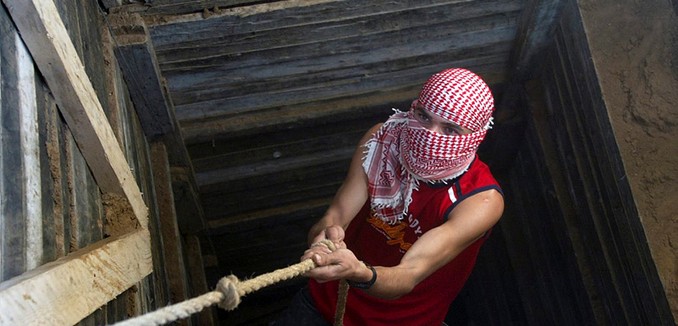Hamas spends an annual $100 million on its military infrastructure in order to prepare for its next war against Israel, Avi Issacharoff of The Times of Israel reported on Thursday, citing estimates by Israeli and Palestinian sources.
Roughly $40 million is spent on employing around 1,500 diggers to build the Iran-backed terror organization’s network of tunnels. Wages for the excavators range from $250 to $400 a month, a high salary for Gaza, which has a high unemployment rate. Diggers also receive bonuses for meeting deadlines, and more experienced diggers are paid higher salaries.
Despite the financial hardships experienced by Gaza residents, Hamas, which in 2014 had a budget of around $530 million, is intent on increasing its military spending. It hopes to upgrade its capabilities, which were degraded during its war with Israel two years ago, and is seeking to develop more precise rockets that could evade Israel’s Iron Dome defensive shield.
To support this effort, Hamas, which Issacharoff observed is “an Islamist terror group avowedly committed to destroying Israel,” has improved its smuggling network to obtain weapons and rocket materials. This May, Israeli authorities uncovered a smuggled shipment of four tons of ammonium chloride concealed in 30 tons of salt. The compound can be employed both as a fertilizer and in the production of rockets. The Israel Tax Authority stated that those four tons could have been used to make hundreds of long-range rockets. “This case underscores the activity of Gaza-based terrorist organizations in smuggling dual-use materials disguised as goods destined for the civilian population and reconstruction projects,” the authority concluded.
Later that month, Israel intercepted another shipment of materials that could be used in the construction of rockets and terror tunnels.
Israeli Foreign Ministry director-general Dore Gold announced in May that Hamas is confiscating 95% of cement that enters Gaza. “From our own investigations we found that out of every 100 sacks of cement that come into the Gaza Strip [from Israel], only five or six are transferred to civilians,” he stated. Hamas uses the cement to build and expand its network of tunnels.
The IDF uncovered two Hamas tunnels that breached Israeli territory in the spring. Hamas used its network of tunnels during the 2014 war to infiltrate into Israel and has continued its efforts to rebuild and expand its infrastructure. Gen. Yossi Kuperwasser, formerly the head of the research division of Israeli military intelligence and later the director general of the Ministry of Strategic Affairs, told reporters in May that the discovery of the tunnels was a sign that Hamas was preparing for another war against Israel. He added that the tunnel digging means that “they definitely invest a lot in making the necessary preparations so that in the next round, when they decide to start it, they will be able to inflict the heaviest damage on Israel, including through those tunnels.”
While Hamas smuggles most of its materials through Israel, it also uses smuggling tunnels from the Sinai and shipping by sea. Egyptian authorities uncovered a 2.5-kilometer (1.5 mile) tunnel in the Sinai Peninsula.
Hamas is working with top officials of ISIS’s Sinai affiliate to facilitate its smuggling operations. The ISIS official in charge of coordinating the effort currently lives in Gaza under the protection of Hamas’s main militia, the Izz ad-Din al-Qassam Brigades.
In Your Complete Guide to Hamas’ Network of Terror Tunnels, which was published in the April 2016 issue of The Tower Magazine, Dan Feferman observed that the people of Gaza pay the price for Hamas’ efforts to rebuild its tunnels.
There is a tragic side to Hamas’ tunnel strategy. Roughly 9,000 homes were destroyed during Protective Edge, and very few have been rebuilt. This is not Israel’s fault, as building supplies flow regularly into Gaza. But according to declassified intelligence reports, these supplies are routinely stolen by Hamas in order to serve the group’s terrorist purposes. Hamas smuggles in cement, diverts from construction and humanitarian donations, and even raids civilian construction sites in order to rebuild its tunnels. Estimates are that one tunnel can cost a million dollars to build and uses around 50,000 tons of concrete. Close to a million tons of concrete were poured into the terror tunnels before 2014.
The tunnels, in this sense, are a zero-sum game. If the same materials were put into reconstruction, the Gazan people would be better off and, lacking this crucial asymmetric warfare capability, Hamas would be less tempted to attack Israel. On the other hand, with the same limited materials going to terror tunnels, the people of Gaza continue to live in ruins while Hamas rebuilds its war machine.
While Hamas appears to be deterred in the short term, it continues to believe that the tunnels are its only strategic weapon. While it may not be interested in another war, the tunnels continue to be dug for a reason. Once used, however, they lose their effectiveness, as the IDF knows their locations and can thus destroy them. Hamas is well aware of this dilemma. The tunnels essentially leave Israel and Hamas in an arms race—with Israel racing to develop a technological solution before Hamas decides to launch another round of fighting.
[Photo: Abed Rahim Khatib / Flash 90 ]




